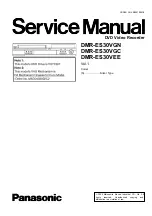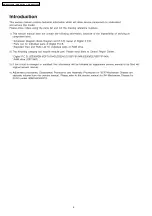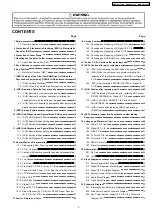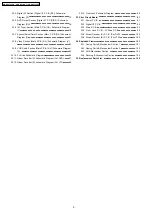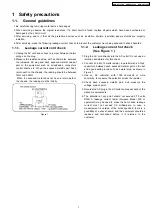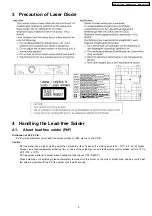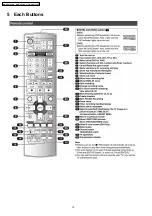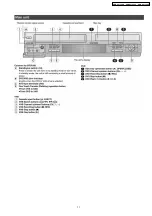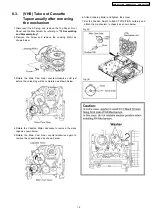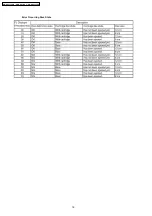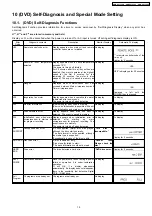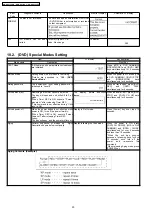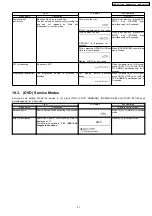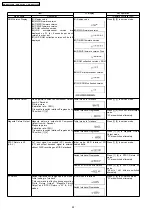
1.1.1. Leakage current cold check
1. Unplug the AC cord and connect a jumper between the two
prongs on the plug.
2. Measure the resistance value, with an ohmmeter, between
the jumpered AC plug and each exposed metallic cabinet
part on the equipment such as screwheads, connectors,
control shafts, etc. When the exposed metallic part has a
return path to the chassis, the reading should be between
1M
Ω
and 5.2M
Ω
.
When the exposed metal does not have a return path to
the chassis, the reading must be infinity.
Figure 1
1.1.2. Leakage current hot check
(See Figure 1 .)
1. Plug the AC cord directly into the AC outlet. Do not use an
isolation transformer for this check.
2. Connect a 1.5k
Ω
, 10 watts resistor, in parallel with a 0.15µF
capacitors, between each exposed metallic part on the set
and a good earth ground such as a water pipe, as shown in
Figure 1.
3. Use an AC voltmeter, with 1000 ohms/volt or more
sensitivity, to measure the potential across the resistor.
4. Check each exposed metallic part, and measure the
voltage at each point.
5. Reverse the AC plug in the AC outlet and repeat each of the
above measurements.
6. The potential at any point should not exceed 0.75 volts
RMS. A leakage current tester (Simpson Model 229 or
equivalent) may be used to make the hot checks, leakage
current must not exceed 1/2 milliampere. In case a
measurement is outside of the limits specified, there is a
possibility of a shock hazard, and the equipment should be
repaired and rechecked before it is returned to the
customer.
1 Safety precautions
1.1. General guidelines
1. Be careful during removing metal parts, sharp edges.
2. When servicing, observe the original lead dress. If a short circuit is found, replace all parts which have been overheated or
damaged by the short circuit.
3. After servicing, see to it that all the protective devices such as insulation barriers, insulation papers shields are properly
installed.
4. After servicing, make the following leakage current checks to prevent the customer from being exposed to shock hazards.
7
DMR-ES30VGN / DMR-ES30VGC / DMR-ES30VEE
Summary of Contents for DMR-ES30VEE
Page 2: ...2 DMR ES30VGN DMR ES30VGC DMR ES30VEE ...
Page 3: ...3 DMR ES30VGN DMR ES30VGC DMR ES30VEE ...
Page 4: ...4 DMR ES30VGN DMR ES30VGC DMR ES30VEE ...
Page 10: ...5 Each Buttons 10 DMR ES30VGN DMR ES30VGC DMR ES30VEE ...
Page 11: ...11 DMR ES30VGN DMR ES30VGC DMR ES30VEE ...
Page 18: ...Error Occurring Disc State 18 DMR ES30VGN DMR ES30VGC DMR ES30VEE ...
Page 28: ...28 DMR ES30VGN DMR ES30VGC DMR ES30VEE ...
Page 40: ...14 2 Checking and Repairing of Digital I F P C B 40 DMR ES30VGN DMR ES30VGC DMR ES30VEE ...
Page 41: ...14 3 Checking and Repairing of Main P C B 41 DMR ES30VGN DMR ES30VGC DMR ES30VEE ...
Page 42: ...14 4 Checking and Repairing of Digital P C B 42 DMR ES30VGN DMR ES30VGC DMR ES30VEE ...
Page 43: ...14 5 Checking and DVD RAM Drive 43 DMR ES30VGN DMR ES30VGC DMR ES30VEE ...
Page 62: ...62 DMR ES30VGN DMR ES30VGC DMR ES30VEE ...
Page 90: ...DMR ES30VGN DMR ES30VGC DMR ES30VEE 90 ...
Page 102: ...24 2 Casing Parts Mechanism Section 2 102 DMR ES30VGN DMR ES30VGC DMR ES30VEE ...
Page 103: ...24 3 VHS Mechanism Section 103 DMR ES30VGN DMR ES30VGC DMR ES30VEE ...
Page 104: ...24 4 Packing Accessories Section 104 DMR ES30VGN DMR ES30VGC DMR ES30VEE ...

